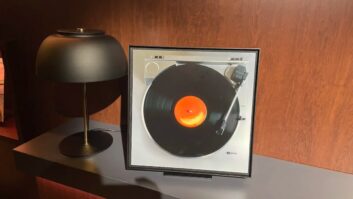ARLINGTON, VA. —
Innovation is the lifeblood of
the consumer electronics industry, inherently disrupting
the status quo, and creating a level of tension to
the industry’s inside-the-Beltway activities.
So it was encouraging to see President
Obama embrace innovation a year
ago in his State Of The Union Address
and announce a “National Wireless
Initiative’”shortly thereafter.
“CEA applauds the President for the focus
on innovation in his State of the Union
address,” CEA president Gary Shapiro
said at the time. Shapiro, who calls innovation
our “secret sauce,” maintained that
the technology industry’s ceaseless innovation
will drive our nation’s recovery and
our economic future.
As always, the devil is in the details and
this year CEA’s government affairs department focused
on several fronts which – like everything in
Washington – require constant attention, effort and
vigilance. These include perennial issues like international
trade, the spectrum crisis, balancing copy protection
with fair use, and protecting the environment
while conserving energy.
The CEA, its leadership and its members sounded
the innovation clarion throughout the year educating
our nation’s legislators and regulators. From visits to
Capitol Hill by company executives, to Shapiro’s regular
columns in Forbes Online and Huffington Post
and his best-selling book “The Comeback: How Innovation
Will Restore the American Dream,” the CEA
has been an advocate for innovation at the forefront
of many beltway battles.
In the spring, as part of a series of industry events
focused on Capitol Hill, members of the CEA’s Board
of Industry Leaders met with members of the House
of Representatives and congressional staff to advocate
for action on these key issues and how they impact
the health of the U.S. economy
These efforts paid off with successes particularly
in the area of trade legislation and rules for accessibility
of consumer electronics products. In the fall, the
Federal Communications Commission (FCC) issued
a notice of rulemaking on the Twenty-First Century
Communications and Video Accessibility Act of 2010
that, thanks in part to input from the CEA, adopted
a balanced approach for manufacturers to add accessibility
features to devices for individuals with disabilities.
Michael Petricone, CEA government affairs
senior VP, said he was pleased to see that “Congress
took a careful approach in drafting this law to promote
the twin goals of increasing accessibility and
preserving innovation. We made an effort to educate
Congress that the best way to foster accessibility of
new products, is trough industry-driven innovation
rather than top-down government mandates. CEA is
committed to continue to work with the accessibility
community as the new rules take effect.”
A big win for consumers and the industry — the
passage of trade agreements with South Korea,
Colombia and Panama — was particularly satisfying
since the CEA had been advocating for these initiatives
consistently for half a decade. American small
businesses need free-trade agreements to restore
their ability to sell products in foreign markets without
imposition of high tariffs. “These bills faced some
determined opposition but we and others kept trying
and fighting with initiatives like the ‘Trade Bus’ and
the ‘Innovation Movement’ that focused on the benefits
of these agreements.” Petricone said. “We’re
thrilled that they were passed and were signed by
the President. They promote manufacturing and jobs,
are good for consumers and the economy, and it’s
good to see Congress do the right thing.”
(The CEA’s Innovation Movement – more
than 110,000 Americans strong – urges
elected leaders to focus on policies that
support innovation and entrepreneurship.)
The increased use of smartphones and
tablet computers has underscored the
need for more spectrum to be allocated
to consumer use. Tablet computer sales
have more than doubled in the past 18
months, fueled by the success of Apple’s
iPad and a legion of competitors now in
stores. Smartphones now represent more
than half of all wireless phone sales and
the use of these devices to access rich internet content
is putting an increasing strain on the airwaves.
At the same time commercial television broadcasters
are sitting on valuable but unused spectrum. The
CEA has encouraged the Congress to allocate a
portion of this unused spectrum to a public auction.
“Spectrum is the oxygen of innovation,” Petricone
said, and freeing up this unused spectrum for use by
the rapidly growing array of wireless devices makes
fiscal sense and is important to our Innovation future.”
There was a hope that the congressional “Super
Committee” would move the ball forward on spectrum
allocation. It seemed to be one of the few
things that the committee could agree on but its
failure to agree on just about anything else doomed
that effort.
As this is written in December, there’s been no
definitive timeline on a possible spectrum auction,
but the CEA execs are optimistic that something will
happen. Incentive auctions to redeploy underused
broadcast spectrum for wireless broadband could
generate $33 billion for the U.S. Treasury reducing
the federal deficit and taking another step toward restoring
the health of the American economy.
A positive step forward was made last month with
the approval by the House Subcommittee on Communications,
Technology and the Internet of the
Jumpstarting Opportunity with Broadband Spectrum
(JOBS) Act of 2011.
There is the ongoing struggle to protect consumers’
rights to use the products they’ve purchased
and have unfettered access to the digital content
available through those devices. Two bills recently in
Congress, the Stop Online Piracy Act (SOPA) in the
House of Representatives and the Protect IP act in
the Senate, sounded good in name, but were overly
restrictive as initially proposed and would have had a
stifling effect on innovation. “We’re very supportive
of a bill if it is done without overly broad definitions
of piracy that are in the current one,” Petricone said.
Environmental issues continue to gain attention
as the number of electronic products in American
homes, autos, pockets and pocketbooks continues
to rise. The industry has made tremendous strides
on both the energy efficiency of its devices and on
responsible recycling and disposal of products that
are being replaced. The CEA continues to advocate
for a national approach
to recycling
and disposal of ewaste
rather than the
patchwork quilt of
state regulations that
now exists.
The CEA launched
in 2011 the first-ever
industry-wide electronics
recycling
initiative to recycle
1 billion pounds of
electronics annually
by 2016, which
would be a more
than threefold increase
over 2010.
The eCycling
Leadership Initiative
seeks to improve
consumer awareness
of the more
than 5,000 collection
sites currently
sponsored by industry,
increase the
amount of electronics
recycled responsibly, increase the number of collection
opportunities available, and provide transparent
metrics on eCycling efforts. One billion pounds
of electronics, if not properly recycled, would fill
about 88.9 million cubic feet, equivalent to an entire
71,000-seat NFL stadium. A major component of the
initiative will be consumer education, including new
online tools and mobile apps, to help make recycling
used electronics as easy as buying new ones.
Another troubling issue arose this year when the
Office of Government Ethics proposed rules that
would severely limit the ability of federal government
employees to attend event like International CES —
sponsored by industry trade groups.
The efforts of the CEA government affairs department
working on behalf of member companies and
consumers who purchase and use these products
will be more critical than ever this year, no matter
what the outcome of this year’s presidential election.
Jim Barry, who has covered the industry for consumer
and trade publications for years, is the media
spokesman of the Consumer Electronics Association.













